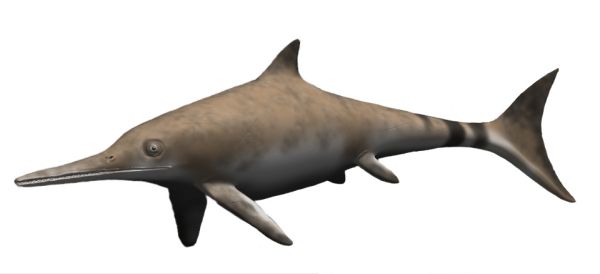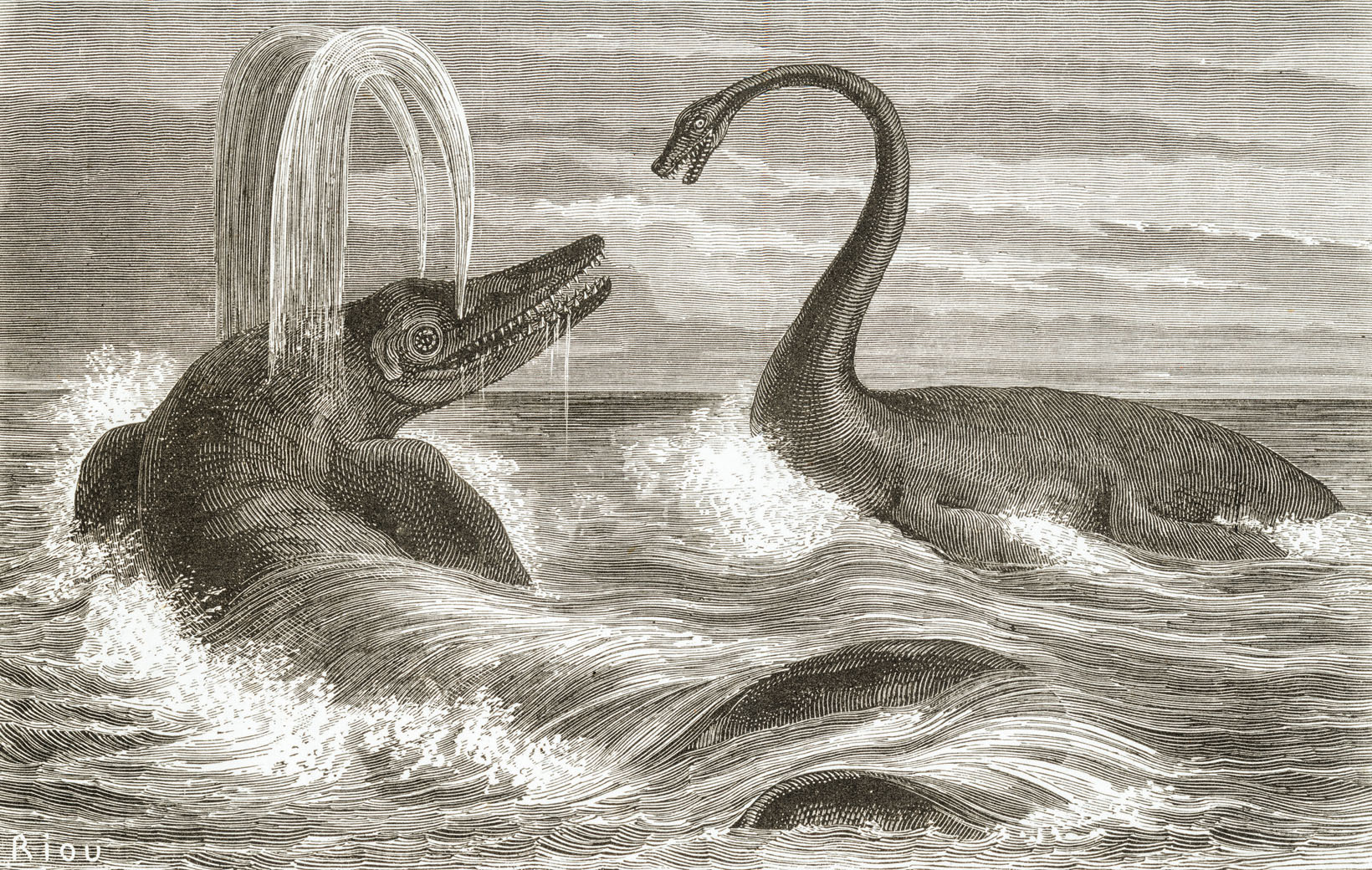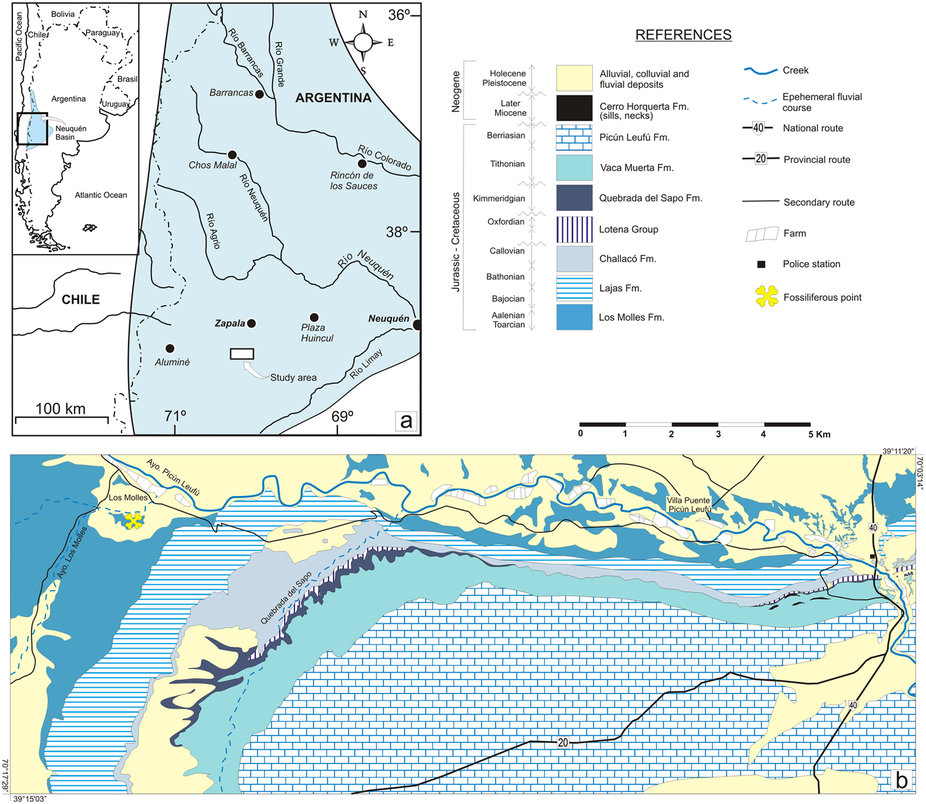|
Chacaicosaurus
''Chacaicosaurus'' is a genus of neoichthyosaurian ichthyosaur known from the Middle Jurassic of Argentina. The single known specimen of this genus was excavated from the Los Molles Formation in Neuquén Province, and is housed at the Museo Olsacher under the specimen number MOZ 5803. This specimen consists of a skull, forelimb, some vertebrae, and some additional postcranial elements. The genus was named by Marta Fernández in 1994, and contains a single species, ''Chacaicosaurus cayi'', making it the first named distinctive ichthyosaur from the Bajocian stage. It is a medium-sized ichthyosaur with a very long snout, which bears a ridge running along each side. The forelimbs of ''Chacaicosaurus'' are small and contain four main digits. Different authors have classified ''Chacaicosaurus'' in different ways; some consider it a thunnosaur closely related to the ophthalmosaurids, others instead place it outside of Thunnosauria, often near ''Hauffiopteryx''. However, as it is very ... [...More Info...] [...Related Items...] OR: [Wikipedia] [Google] [Baidu] |
Ophthalmosaurid
Ophthalmosauridae is an extinct family of thunnosaur ichthyosaurs from the Middle Jurassic to the early Late Cretaceous (Bajocian - Cenomanian) worldwide. Almost all ichthyosaurs from the Middle Jurassic onwards belong to the family, until the extinction of ichthyosaurs in the early Late Cretaceous. Opthalmosaurids appeared worldwide during early Bajocian, subsequent to the disappearance of most other ichthyosaur lineages after the end of the Toarcian. Currently, the oldest known ophthalmosaurids is '' Mollesaurus'' from the early Bajocian of Argentina, as well as indeterminate remains of the same age from Luxembourg and Canada. Named by George H. Baur, in 1887, the family contains the basal taxa like ''Ophthalmosaurus''. Appleby (1956) named the taxon Ophthalmosauria which was followed by some authors, but these two names are often treated as synonyms; Ophthalmosauridae has the priority over Ophthalmosauria. However, some researchers argue that Ophthalmosauridae should be restric ... [...More Info...] [...Related Items...] OR: [Wikipedia] [Google] [Baidu] |
Stenopterygius
''Stenopterygius'' is an extinct genus of thunnosaur ichthyosaur known from Europe (England, France, Germany, Luxembourg and Switzerland). This genus of ichthyosaur was about long and weighed .Huene F. von 1939. Ein ganzes Ichthyosaurier-Skelett aus den westschweizerischen Voralpen. ''Mitteilungen der Naturforschenden Gesellschaft in Bern'' 1939, pp.: 1-14McGowan C, Motani R. 2003. Ichthyopterygia. – In: Sues, H.-D. (ed.): ''Handbook of Paleoherpetology, Part 8, Verlag Dr. Friedrich Pfeil'', 175 pp., 101 figs., 19 plts; München History ''Stenopterygius'' was originally named by Quenstedt in 1856 as a species of ''Ichthyosaurus'', ''I. quadriscissus''. Otto Jaekel in 1904 reassigned it to its own genus, ''Stenopterygius''. The type species is therefore ''Stenopterygius quadriscissus''. The generic name is derived from ''stenos'', Greek for "narrow", and ''pteryx'' (πτερυξ), Greek for "fin" or "wing". Description ''Stenopterygius'' was physically similar to the bette ... [...More Info...] [...Related Items...] OR: [Wikipedia] [Google] [Baidu] |
Mollesaurus
''Mollesaurus'' is an extinct genus of large ophthalmosaurine ophthalmosaurid ichthyosaur known from northwestern Patagonia of Argentina. Etymology ''Mollesaurus'' was named by Marta S. Fernández in 1999 and the type species is ''Mollesaurus periallus''. The generic name is derived from the name of the Los Molles Formation, where the holotype was collected, and ''sauros'', Greek for "lizard". The specific name is derived from ''periallos'', Greek for "before all others", in reference to the fact that it is the oldest ophthalmosaurid and one of the oldest thunnosaurs. History of study ''Mollesaurus'' is known from the holotype MOZ 2282 V, articulated partial skeleton which preserved partial skull and most of the vertebral column. It was collected in the Chacaico Sur locality from the ''Emileia giebeli'' ammonoid zone of the Los Molles Formation, Cuyo Group, dating to the early Bajocian stage of the Middle Jurassic, about 171.6-170 million years ago. ''Mollesau ... [...More Info...] [...Related Items...] OR: [Wikipedia] [Google] [Baidu] |
Thunnosaur
Thunnosauria (Greek for "tuna lizard" – ''thunnos'' meaning "tuna" and ''sauros'' meaning "lizard") is an extinct clade of parvipelvian ichthyosaurs from the Early Jurassic to the early Late Cretaceous (Hettangian– Cenomanian) of Asia, Australia, Europe, North America, and South America. Named by Ryosuke Motani in 1999, it contains the basal taxa ''Ichthyosaurus'' and ''Stenopterygius'' and the family Ophthalmosauridae. In thunnosaurs, the fore fin is at least twice as long as the hind fin. Phylogeny Thunnosauria is a node-based taxon defined in 1999 as "the last common ancestor of ''Ichthyosaurus communis'' and ''Stenopterygius quadriscissus'' and all of its descendants". The cladogram A cladogram (from Greek ''clados'' "branch" and ''gramma'' "character") is a diagram used in cladistics to show relations among organisms. A cladogram is not, however, an evolutionary tree because it does not show how ancestors are related to ... below follows the topology from a ... [...More Info...] [...Related Items...] OR: [Wikipedia] [Google] [Baidu] |
Ichthyosaur
Ichthyosaurs (Ancient Greek for "fish lizard" – and ) are large extinct marine reptiles. Ichthyosaurs belong to the order known as Ichthyosauria or Ichthyopterygia ('fish flippers' – a designation introduced by Sir Richard Owen in 1842, although the term is now used more for the parent clade of the Ichthyosauria). Ichthyosaurs thrived during much of the Mesozoic era; based on fossil evidence, they first appeared around 250 million years ago ( Ma) and at least one species survived until about 90 million years ago, into the Late Cretaceous. During the Early Triassic epoch, ichthyosaurs and other ichthyosauromorphs evolved from a group of unidentified land reptiles that returned to the sea, in a development similar to how the mammalian land-dwelling ancestors of modern-day dolphins and whales returned to the sea millions of years later, which they gradually came to resemble in a case of convergent evolution. Ichthyosaurs were particularly abundant in the Late Triassic ... [...More Info...] [...Related Items...] OR: [Wikipedia] [Google] [Baidu] |
Los Molles Formation
The Los Molles Formation is a geologic formation of Early to Middle Jurassic age, located at northern and central part of Neuquén Basin at Mendoza Shelf in Argentina. It is overlain by the Niyeu–Lajas Formation.McIlroy et al., 2005 Description It is the second largest oil and gas formation in the Neuquén Basin after the Vaca Muerta. Los Molles Formation is estimated to have of technically recoverable shale gas and of technically recoverable oil.EIA, 2013 In July 2015, the ''Buenos Aires Herald'' indicated that Pan American Energy and YPF planned to drill 46 shale gas wells in Los Molles over the next four years in their Lindero Atravesado drilling block, at an estimated cost of US$590 million. Fossil content In several outcrops, the Los Molles formation has been the site of paleontological discoveries: the ichthyosaurs ''Chacaicosaurus'' and '' Mollesaurus'', and, in 2017, an ornithischian, ''Isaberrysaura'', discovered with fossilized contents of the gut.Salgado ... [...More Info...] [...Related Items...] OR: [Wikipedia] [Google] [Baidu] |
Patagonia
Patagonia () refers to a geographical region that encompasses the southern end of South America, governed by Argentina and Chile. The region comprises the southern section of the Andes Mountains with lakes, fjords, temperate rainforests, and glaciers in the west and deserts, tablelands and steppes to the east. Patagonia is bounded by the Pacific Ocean on the west, the Atlantic Ocean to the east, and many bodies of water that connect them, such as the Strait of Magellan, the Beagle Channel, and the Drake Passage to the south. The Colorado and Barrancas rivers, which run from the Andes to the Atlantic, are commonly considered the northern limit of Argentine Patagonia. The archipelago of Tierra del Fuego is sometimes included as part of Patagonia. Most geographers and historians locate the northern limit of Chilean Patagonia at Huincul Fault, in Araucanía Region.Manuel Enrique Schilling; Richard WalterCarlson; AndrésTassara; Rommulo Vieira Conceição; Gustavo Walter B ... [...More Info...] [...Related Items...] OR: [Wikipedia] [Google] [Baidu] |
Zulma Gasparini
Zulma Nélida Brandoni de Gasparini (born 15 May 1944) is an Argentinian paleontologist and zoologist. She is known for discovering the fossils of the dinosaur '' Gasparinisaura'', which was named after her. Work Born in the city of La Plata, Argentina on 15 May 1944, Brandoni de Gasparini graduated in zoology from the National University of La Plata in 1966 and obtained her PhD in Natural Sciences in 1973. Zulma Brandoni de Gasparini was internationally recognized in the nineties for leading the team that discovered the Gasparinisaura. She is a recognized expert in Mesozoic reptilians of South America. In 1972, she started her scientific career at the CONICET, in which was promoted in 2003 to the grade of ''Superior Researcher''. She is today professor in Paleontology of Vertebrates in the National University of La Plata. Honours Brandoni de Gasparini has been awarded, among others recognitions, the Prize "Bernardo Houssay" of the CONICET (1987), the Prize to the Meri ... [...More Info...] [...Related Items...] OR: [Wikipedia] [Google] [Baidu] |
Thalattosuchian
Thalattosuchia is a clade of marine crocodylomorphs from the Early Jurassic to the Early Cretaceous that had a cosmopolitan distribution. They are colloquially referred to as marine crocodiles or sea crocodiles, though they are not members of Crocodilia and records from Thailand and China suggest that some members lived in freshwater. The clade contains two major subgroupings, the Teleosauroidea and Metriorhynchoidea. Teleosauroids are not greatly specialised for oceanic life, with back osteoderms similar to other crocodyliformes. Within Metriorhynchoidea, the Metriorhynchidae displayed extreme adaptions for life in the open ocean, including the transformation of limbs into flippers, the development of a tail fluke, and smooth, scaleless skin. Discovery and naming The term Thalattosuchia was coined by Fraas in 1901.Fraas E. 1901. Die Meerkrokodile (Thalattosuchia n. g.) eine neue Sauriergruppe der Juraformation. ''Jahreshefte des Vereins für vaterländische Naturkunde, Württe ... [...More Info...] [...Related Items...] OR: [Wikipedia] [Google] [Baidu] |
Invertebrate
Invertebrates are a paraphyletic group of animals that neither possess nor develop a vertebral column (commonly known as a ''backbone'' or ''spine''), derived from the notochord. This is a grouping including all animals apart from the chordate subphylum Vertebrata. Familiar examples of invertebrates include arthropods, mollusks, annelids, echinoderms and cnidarians. The majority of animal species are invertebrates; one estimate puts the figure at 97%. Many invertebrate taxa have a greater number and variety of species than the entire subphylum of Vertebrata. Invertebrates vary widely in size, from 50 μm (0.002 in) rotifers to the 9–10 m (30–33 ft) colossal squid. Some so-called invertebrates, such as the Tunicata and Cephalochordata, are more closely related to vertebrates than to other invertebrates. This makes the invertebrates paraphyletic, so the term has little meaning in taxonomy. Etymology The word "invertebrate" comes from the Latin word ''vertebra' ... [...More Info...] [...Related Items...] OR: [Wikipedia] [Google] [Baidu] |
Zapala Department
Zapala is a department located in the center of Neuquén Province, Argentina. Geography The Department limits with Confluencia Department at the East, Añelo Department at the northeast, Picún Leufú Department at southeast, Catán Lil Department Catán Lil is a department located in the center of Neuquén Province, Argentina. Geography The Department limits with Picunches Department at north, Zapala Department at northeast, Picún Leufú Department at east, Collón Curá Department at s ... at southwest and Picunches Department at northwest. {{Coord, 38, 54, 10, S, 70, 03, 53, W, source:kolossus-eswiki, display=title Departments of Neuquén Province ... [...More Info...] [...Related Items...] OR: [Wikipedia] [Google] [Baidu] |
Museo De La Plata
The La Plata Museum ( es, Museo de la Plata) is a natural history museum in La Plata, Argentina. It is part of the (Natural Sciences School) of the UNLP (National University of La Plata). The building, long, today houses 3 million fossils and relics (including 44,000 botanical items), an amphitheatre, opened in 1992, and a 58,000-volume library, serving over 400 university researchers. Around 400,000 visitors (8% of whom are from outside Argentina) pass through its doors yearly, including a thousand visiting researchers. History Childhood excursions with his father and older brother led the 14-year-old Francisco Moreno to mount a display of his growing collection of anthropological, fossil and bone findings at his family's Buenos Aires home in 1866, unwittingly laying the foundations for the future La Plata Museum. Moreno spent the time between 1873 and 1877 exploring his country's then-remote and largely unmapped Patagonia, becoming the first non-indigenous Argentine to rea ... [...More Info...] [...Related Items...] OR: [Wikipedia] [Google] [Baidu] |






